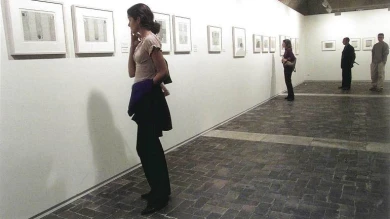Cristino de Vera. Drawings

The artist trains in Madrid as a painter and pupil of Daniel Vázquez Díaz in the early fifties and his work constantly shows influences of Baroque ideals both in iconography and conceptually. His work moves between the idea of death and mystical experience, vanitas being the predominant issue in the drawings from this exhibition. In them, de Vera reaches a maximum degree of spirituality, by insisting on simple compositions in which the few existing elements become a model of mystical transcendence, sublimated in its formal purification.
Cristino de Vera develops various resources with which to achieve representation of the act of meditation as a way of perfection. The shifting of the image away from the centre of the sheet of paper allows him to exalt the beauty of the white surface while distributing it. He also works with the light given by the empty centre of the white sheet of paper, contrasts and vibration arising from the frames and grids of ink. With all this the bodies and objects represented are endowed with density and its austere Baroque influence is embodied.
The artist does not hide that in the origins of his drawings the ascetic synthesis of Francisco de Zurbaran’s whites can be found. The agreement of geometry as a pictorial and compositional tool also stands out, as used by Fra Angelico, Rogier van der Weyden, Paul Cézanne and Juan Gris along the history of painting.
The drawings collected for this exhibition are grouped into series, according to the represented motifs: skulls, roses, candles, figurines, mirrors, towels, cups and bowls. The compositional simplicity, the absence of ornaments and geometric simplification of the volumes together with the emphasis on iconography respond to their willingness to connect with the tradition of mysticism, transcending religion to settle into art.
The artist himself believes he is mystic, if mystic means "the pursuit of spiritual and metaphysical values, geometric order of white silence and detachment of forms that lead us to appreciate rhythms, lights, shapes, different orders." From the drawings on display, the series on Pepe Espaliú is worth noting, where he pays homage to the artist and friend, and calls back the spirit of the baroque vanitas.
Centro Atlántico de Arte Moderno, Las Palmas de Gran Canaria
Organised by
Museo Nacional Centro de Arte Reina Sofía
Image gallery

